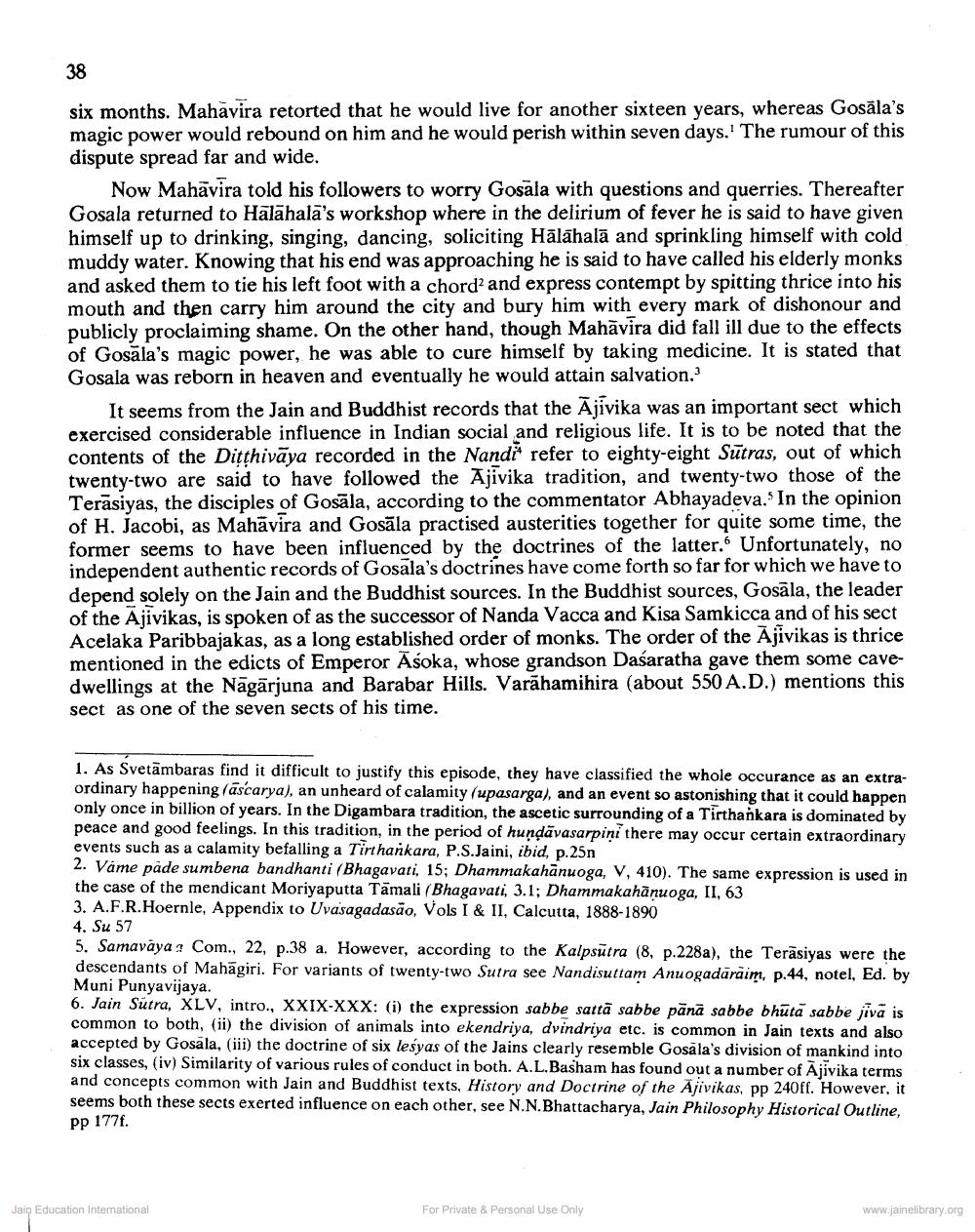________________
38
six months. Mahavira retorted that he would live for another sixteen years, whereas Gosāla's magic power would rebound on him and he would perish within seven days. The rumour of this dispute spread far and wide.
Now Mahavira told his followers to worry Gosala with questions and querries. Thereafter Gosala returned to Hālāhala's workshop where in the delirium of fever he is said to have given himself up to drinking, singing, dancing, soliciting Hālähalā and sprinkling himself with cold muddy water. Knowing that his end was approaching he is said to have called his elderly monks and asked them to tie his left foot with a chord and express contempt by spitting thrice into his mouth and then carry him around the city and bury him with every mark of dishonour and publicly proclaiming shame. On the other hand, though Mahāvira did fall ill due to the effects of Gosāla's magic power, he was able to cure himself by taking medicine. It is stated that Gosala was reborn in heaven and eventually he would attain salvation.
It seems from the Jain and Buddhist records that the Ājivika was an important sect which exercised considerable influence in Indian social and religious life. It is to be noted that the contents of the Ditthivāya recorded in the Nandi refer to eighty-eight Sūtras, out of which twenty-two are said to have followed the Ajivika tradition, and twenty-two those of the Terasiyas, the disciples of Gosāla, according to the commentator Abhayadeva. In the opinion of H. Jacobi, as Mahāvira and Gosāla practised austerities together for quite some time, the former seems to have been influenced by the doctrines of the latter. Unfortunately, no independent authentic records of Gosala's doctrines have come forth so far for which we have to depend solely on the Jain and the Buddhist sources. In the Buddhist sources, Gosāla, the leader of the Ajivikas, is spoken of as the successor of Nanda Vacca and Kisa Samkicca and of his sect Acelaka Paribbajakas, as a long established order of monks. The order of the Ajivikas is thrice mentioned in the edicts of Emperor Asoka, whose grandson Dasaratha gave them some cavedwellings at the Nagarjuna and Barabar Hills. Varāhamihira (about 550 A.D.) mentions this sect as one of the seven sects of his time.
1. As Svetāmbaras find it difficult to justify this episode, they have classified the whole occurance as an extraordinary happening (ascarya), an unheard of calamity (upasarga), and an event so astonishing that it could happen only once in billion of years. In the Digambara tradition, the ascetic surrounding of a Tirthankara is dominated by peace and good feelings. In this tradition, in the period of hundāvasarpiņi there may occur certain extraordinary events such as a calamity befalling a Tirtharkara, P.S.Jaini, ibid, p.25n 2. Vame pade sumbena bandhanti (Bhagavati, 15; Dhammakahānuoga, V, 410). The same expression is used in the case of the mendicant Moriyaputta Tämali (Bhagavati, 3.1; Dhammakahānuoga, II. 63 3. A.F.R.Hoernle, Appendix to Uvasagadasão, Vols I & II, Calcutta, 1888-1890 4. Su 57 5. Samavaya . Com., 22, p.38 a. However, according to the Kalpsutra (8, p.228a), the Terasiyas were the descendants of Mahāgiri. For variants of twenty-two Sutra see Nandisuttam Anuogadāraim, p.44, notel, Ed. by Muni Punyavijaya. 6. Jain Sutra, XLV, intro., XXIX-XXX: (i) the expression sabbe sattā sabbe pānä sabbe bhūtā sabbe jiva is common to both, (ii) the division of animals into ekendriya, dvindriya etc. is common in Jain texts and also accepted by Gosala, (iii) the doctrine of six lesyas of the Jains clearly resemble Gosala's division of mankind into six classes, (iv) Similarity of various rules of conduct in both. A.L.Basham has found out a number of Ajivika terms and concepts common with Jain and Buddhist texts, History and Doctrine of the Ajivikas, pp 240ff. However, it seems both these sects exerted influence on each other, see N.N.Bhattacharya, Jain Philosophy Historical Outline, pp 177f.
Jain Education International
For Private & Personal Use Only
www.jainelibrary.org




